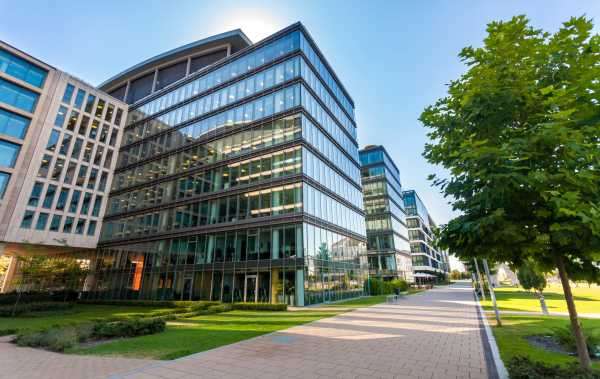
For two years, government lockdowns over Covid-19 kept office workers home. Now, it seems, there is a mad scramble to lure workers back, creating the possibility of an office-space glut and making it more challenging to convert those spaces for more needed uses, like housing.
Most firms have reopened their offices in some capacity, but only 4 percent of employers surveyed are requiring employees to come back to the office full-time. In Q1 2022, office vacancies still sit at over 12 percent. In April in Midtown Manhattan, 19 percent of offices were vacant. Housing rentals, by comparison, have a 5.6 percent vacancy rate nationally, speaking to America’s notorious home shortage.
Advertisement
So there have been calls to convert vacant space to housing. On-the-ground interest had increased even before Covid. In the Washington, D.C. market, for instance, six conversions advanced between 2019 and 2021. Laurence Caudle, an architect with Hickok Cole, observed, “for us I would say that if we did one study a year, now we’ve probably done a dozen studies in the last six months.”
But there are challenges with conversion. “Everybody talks a good game,” said Northern Virginia land-use attorney David Gill. But “when you get to the details of it, it is complicated.”
The challenges can be broken down into three categories: economic, engineering, and regulatory.
The first challenge is that office space can still be pretty lucrative, depending on what type.
Class A office space remains in high demand and gets a per-square-foot rental premium. Class A offices tend to be within urban cores and house large corporations. Class B and C buildings are older and not as centrally located.
Advertisement
An analysis by the D.C. Policy Center found that while a Class C office building could increase in value if converted to residential, converting it to Class A would yield even higher returns. Banks also may be reluctant to back conversion projects.
But not all Class C buildings are so convertible. “There might be some buildings that are B and C class office that…are not the right configuration to make attractive Class A space, and might actually be better converted to residential,” said Strachan Forgan, a San Francisco-based architect with Solomon Cordwell Buenz.
“We’re still not gonna beat trophy-class A rents,” added Caudle, “but class B…in urban cores that are transitioning to more 24-7 urban cores, we’re seeing a lot of interest in [residential conversion].” NBC New York reported that “10 percent of Midtown’s older, less-than-prime office space could be converted to residential use, generating 14,000 new apartments.”
But conversions may become even more substantial in the suburbs. In 2017, 46 percent of vacant office space in Montgomery County, MD was located in suburbs. As Gill argued, pre-pandemic demand for office space was greater in mixed-use areas, while suburban space suffered. One successful conversion that Gill pointed to was 5600 Columbia Pike in Northern Virginia, which reactivated a long-vacant office building by turning it into 157 residential units.
A study of office-to-residential in Paris found that the greatest potential was in far suburbs, not centralized business districts. Given the rise of walkable “lifestyle centers” in American and European suburbs, it’s plausible that office parks could become new urban neighborhoods.
Office and residential structures are built with different needs and in different methods, which sometimes act at cross purposes.
“The rule of thumb in the market is an ideal office building is about 20 [thousand]-square-foot floor plates, typically six to ten stories,” Gill explains. “You end up with a single center core with quite a bit of space around it, so you end up with really long and deep spaces. In order to convert that space to residential, you’ve gotta figure out a way to divide it and still give people their windows.”
Residential buildings tend to use concrete, while offices use steel. The Montgomery County planning department elaborates: “Many architectural elements unique to an office building, such as deep floor plates, closely spaced structural columns and dedicated core space, can create challenges for residential use.” It’s also necessary to account for sewer and electrical capacity.
These discrepancies between office and residential can lead to creative decision-making—and not in a good way. One project that Hickok Cole worked on entailed demolishing all but the first two floors of a building.
However, the architects that we interviewed said that if such conversions are possible, they bring environmental benefits, given that they recycle old buildings.
“You could build 20-30 LEED new buildings, but you still are gonna have a lot more of a carbon footprint than you would be converting the same 20-30 adaptive-reuse buildings,” Gill noted.
Developers must also contend with land-use rules. A conversion in Alexandria, VA, according to Gill, occurred within a “special district” where these can be undertaken by-right. But in nearby Fairfax County, the process is harder.
“It takes at least a year to get through a zoning process typically,” Gill said, accounting for public input and assembling necessary documents. The costs of entitlement are also high, as much as $1 million. “That’s a lot of upfront cash for a project.”
Caudle points to mixed-use zoning as beneficial for conversions. However, this can backfire if regulators establish arbitrary caps on each use. In Baltimore, for instance, one neighborhood designated as “mixed-use” requires buildings to include substantial portions for either industrial or retail uses, rather than simply allowing what the market will command.
Legislation in New York State would reform design regulations for office conversions in Manhattan’s core. Current rules in Midtown Manhattan cap conversions at 250,000 square feet. Montgomery County planning authorities observe that “many successful conversions depend on some degree of regulatory relief or even financial incentives from the public sector.”
But it would be best to simply allow them by-right; given how hard conversions are from an engineering standpoint, there is little use in city governments making the process even harder with zoning arcana. Cities right now are facing simultaneously an urban housing shortage and a likely structural decline in office use; conversions kill these two birds with one stone. The various conversions underway prove that developers are interested in them.
Concluded Forgan: “If our cities are gonna survive, we have to do something fairly quickly to get people back into the urban cores. We need to get people downtown.”
Subscribe Today Get weekly emails in your inbox Email Address:
If this return isn’t going to happen through return to offices, it will need to happen by making downtown living cheaper via more housing.
This article featured additional reporting from Market Urbanism Report content staffer Ethan Finlan.
The New Urbanism series is supported by the Richard H. Driehaus Foundation. Follow New Urbs on Twitter for a feed dedicated to TAC’s coverage of cities, urbanism, and place.
Advertisement
Sourse: theamericanconservative.com






